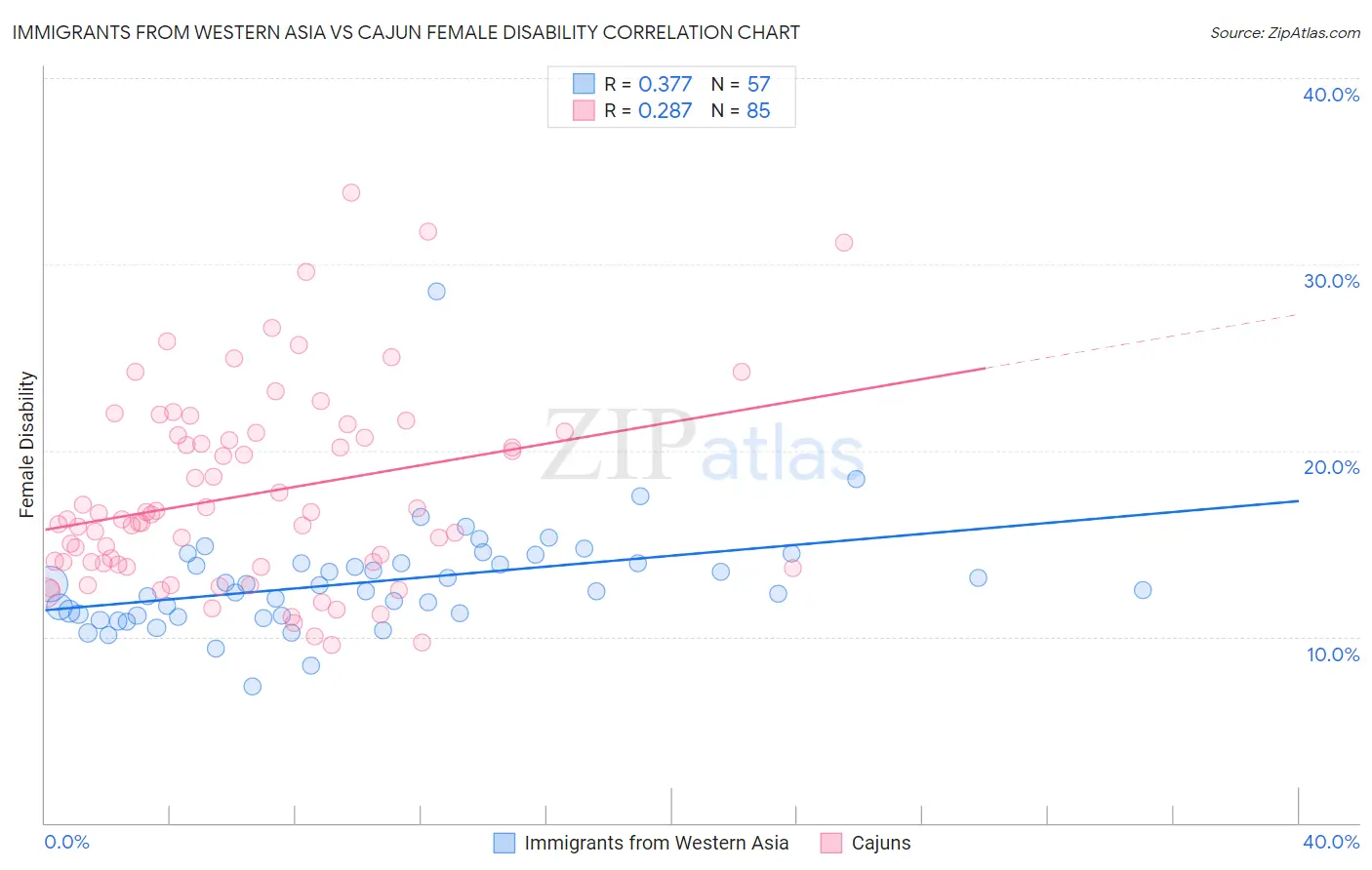Immigrants from Western Asia vs Cajun Female Disability
COMPARE
Immigrants from Western Asia
Cajun
Female Disability
Female Disability Comparison
Immigrants from Western Asia
Cajuns
11.7%
FEMALE DISABILITY
98.3/ 100
METRIC RATING
104th/ 347
METRIC RANK
14.9%
FEMALE DISABILITY
0.0/ 100
METRIC RATING
335th/ 347
METRIC RANK
Immigrants from Western Asia vs Cajun Female Disability Correlation Chart
The statistical analysis conducted on geographies consisting of 404,394,576 people shows a mild positive correlation between the proportion of Immigrants from Western Asia and percentage of females with a disability in the United States with a correlation coefficient (R) of 0.377 and weighted average of 11.7%. Similarly, the statistical analysis conducted on geographies consisting of 149,701,485 people shows a weak positive correlation between the proportion of Cajuns and percentage of females with a disability in the United States with a correlation coefficient (R) of 0.287 and weighted average of 14.9%, a difference of 26.8%.

Female Disability Correlation Summary
| Measurement | Immigrants from Western Asia | Cajun |
| Minimum | 7.3% | 9.6% |
| Maximum | 28.6% | 33.8% |
| Range | 21.3% | 24.2% |
| Mean | 12.9% | 17.7% |
| Median | 12.5% | 16.3% |
| Interquartile 25% (IQ1) | 11.1% | 13.9% |
| Interquartile 75% (IQ3) | 14.0% | 20.9% |
| Interquartile Range (IQR) | 2.8% | 7.0% |
| Standard Deviation (Sample) | 3.0% | 5.2% |
| Standard Deviation (Population) | 2.9% | 5.2% |
Similar Demographics by Female Disability
Demographics Similar to Immigrants from Western Asia by Female Disability
In terms of female disability, the demographic groups most similar to Immigrants from Western Asia are Immigrants from Eastern Africa (11.7%, a difference of 0.010%), Australian (11.7%, a difference of 0.020%), Immigrants from Greece (11.7%, a difference of 0.040%), Latvian (11.7%, a difference of 0.070%), and Immigrants from South Eastern Asia (11.7%, a difference of 0.080%).
| Demographics | Rating | Rank | Female Disability |
| Koreans | 99.0 /100 | #97 | Exceptional 11.7% |
| Uruguayans | 98.8 /100 | #98 | Exceptional 11.7% |
| Immigrants | Philippines | 98.6 /100 | #99 | Exceptional 11.7% |
| Immigrants | Uruguay | 98.5 /100 | #100 | Exceptional 11.7% |
| Immigrants | Costa Rica | 98.4 /100 | #101 | Exceptional 11.7% |
| Immigrants | South Eastern Asia | 98.4 /100 | #102 | Exceptional 11.7% |
| Immigrants | Eastern Africa | 98.3 /100 | #103 | Exceptional 11.7% |
| Immigrants | Western Asia | 98.3 /100 | #104 | Exceptional 11.7% |
| Australians | 98.3 /100 | #105 | Exceptional 11.7% |
| Immigrants | Greece | 98.2 /100 | #106 | Exceptional 11.7% |
| Latvians | 98.2 /100 | #107 | Exceptional 11.7% |
| New Zealanders | 98.1 /100 | #108 | Exceptional 11.7% |
| Immigrants | Immigrants | 98.1 /100 | #109 | Exceptional 11.7% |
| Soviet Union | 98.1 /100 | #110 | Exceptional 11.7% |
| Costa Ricans | 98.1 /100 | #111 | Exceptional 11.7% |
Demographics Similar to Cajuns by Female Disability
In terms of female disability, the demographic groups most similar to Cajuns are Cherokee (14.9%, a difference of 0.020%), Immigrants from the Azores (14.9%, a difference of 0.11%), Pima (14.8%, a difference of 0.50%), Seminole (15.0%, a difference of 0.67%), and Tohono O'odham (15.0%, a difference of 0.80%).
| Demographics | Rating | Rank | Female Disability |
| Cape Verdeans | 0.0 /100 | #328 | Tragic 14.2% |
| Osage | 0.0 /100 | #329 | Tragic 14.3% |
| Yuman | 0.0 /100 | #330 | Tragic 14.5% |
| Immigrants | Cabo Verde | 0.0 /100 | #331 | Tragic 14.6% |
| Pima | 0.0 /100 | #332 | Tragic 14.8% |
| Immigrants | Azores | 0.0 /100 | #333 | Tragic 14.9% |
| Cherokee | 0.0 /100 | #334 | Tragic 14.9% |
| Cajuns | 0.0 /100 | #335 | Tragic 14.9% |
| Seminole | 0.0 /100 | #336 | Tragic 15.0% |
| Tohono O'odham | 0.0 /100 | #337 | Tragic 15.0% |
| Dutch West Indians | 0.0 /100 | #338 | Tragic 15.0% |
| Colville | 0.0 /100 | #339 | Tragic 15.1% |
| Chickasaw | 0.0 /100 | #340 | Tragic 15.2% |
| Choctaw | 0.0 /100 | #341 | Tragic 15.4% |
| Creek | 0.0 /100 | #342 | Tragic 15.7% |